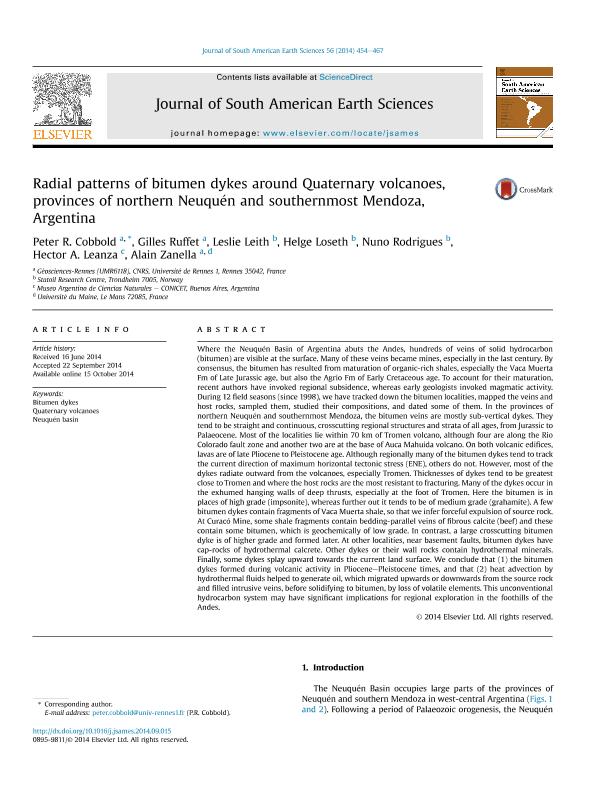Mostrar el registro sencillo del ítem
dc.contributor.author
Cobbold, Peter R.
dc.contributor.author
Ruffet, Gilles
dc.contributor.author
Leith, Leslie
dc.contributor.author
Loseth, Helge
dc.contributor.author
Rodrigues, Nuno
dc.contributor.author
Leanza, Hector Armando

dc.contributor.author
Zanella, Alain
dc.date.available
2017-07-14T14:53:02Z
dc.date.issued
2014-10
dc.identifier.citation
Cobbold, Peter R.; Ruffet, Gilles; Leith, Leslie; Loseth, Helge; Rodrigues, Nuno; et al.; Radial patterns of bitumen dykes around Quaternary volcanoes, provinces of northern Neuquén and southernmost Mendoza, Argentina; Elsevier; Journal of South American Earth Sciences; 56; 10-2014; 454-467
dc.identifier.issn
0895-9811
dc.identifier.uri
http://hdl.handle.net/11336/20503
dc.description.abstract
Where the Neuquén Basin of Argentina abuts the Andes, hundreds of veins of solid hydrocarbon (bitumen) are visible at the surface. Many of these veins became mines, especially in the last century. By consensus, the bitumen has resulted from maturation of organic-rich shales, especially the Vaca Muerta Fm of Late Jurassic age, but also the Agrio Fm of Early Cretaceous age. To account for their maturation, recent authors have invoked regional subsidence, whereas early geologists invoked magmatic activity. During 12 field seasons (since 1998), we have tracked down the bitumen localities, mapped the veins and host rocks, sampled them, studied their compositions, and dated some of them. In the provinces of northern Neuquén and southernmost Mendoza, the bitumen veins are mostly sub-vertical dykes. They tend to be straight and continuous, crosscutting regional structures and strata of all ages, from Jurassic to Palaeocene. Most of the localities lie within 70 km of Tromen volcano, although four are along the Rio Colorado fault zone and another two are at the base of Auca Mahuida volcano. On both volcanic edifices, lavas are of late Pliocene to Pleistocene age. Although regionally many of the bitumen dykes tend to track the current direction of maximum horizontal tectonic stress (ENE), others do not. However, most of the dykes radiate outward from the volcanoes, especially Tromen. Thicknesses of dykes tend to be greatest close to Tromen and where the host rocks are the most resistant to fracturing. Many of the dykes occur in the exhumed hanging walls of deep thrusts, especially at the foot of Tromen. Here the bitumen is in places of high grade (impsonite), whereas further out it tends to be of medium grade (grahamite). A few bitumen dykes contain fragments of Vaca Muerta shale, so that we infer forceful expulsion of source rock. At Curacó Mine, some shale fragments contain bedding-parallel veins of fibrous calcite (beef) and these contain some bitumen, which is geochemically of low grade. In contrast, a large crosscutting bitumen dyke is of higher grade and formed later. At other localities, near basement faults, bitumen dykes have cap-rocks of hydrothermal calcrete. Other dykes or their wall rocks contain hydrothermal minerals. Finally, some dykes splay upward towards the current land surface. We conclude that (1) the bitumen dykes formed during volcanic activity in Pliocene–Pleistocene times, and that (2) heat advection by hydrothermal fluids helped to generate oil, which migrated upwards or downwards from the source rock and filled intrusive veins, before solidifying to bitumen, by loss of volatile elements. This unconventional hydrocarbon system may have significant implications for regional exploration in the foothills of the Andes.
dc.format
application/pdf
dc.language.iso
eng
dc.publisher
Elsevier

dc.rights
info:eu-repo/semantics/openAccess
dc.rights.uri
https://creativecommons.org/licenses/by-nc-nd/2.5/ar/
dc.subject
Bitumen Dykes
dc.subject
Quaternary Volcanoes
dc.subject
Neuquen Basin
dc.subject.classification
Geología

dc.subject.classification
Ciencias de la Tierra y relacionadas con el Medio Ambiente

dc.subject.classification
CIENCIAS NATURALES Y EXACTAS

dc.title
Radial patterns of bitumen dykes around Quaternary volcanoes, provinces of northern Neuquén and southernmost Mendoza, Argentina
dc.type
info:eu-repo/semantics/article
dc.type
info:ar-repo/semantics/artículo
dc.type
info:eu-repo/semantics/publishedVersion
dc.date.updated
2017-06-28T19:41:17Z
dc.journal.number
56
dc.journal.pagination
454-467
dc.journal.pais
Países Bajos

dc.journal.ciudad
Amsterdam
dc.description.fil
Fil: Cobbold, Peter R.. Universite de Rennes I; Francia
dc.description.fil
Fil: Ruffet, Gilles. Universite de Rennes I; Francia
dc.description.fil
Fil: Leith, Leslie. Statoil Research Centre; Noruega
dc.description.fil
Fil: Loseth, Helge. Statoil Research Centre; Noruega
dc.description.fil
Fil: Rodrigues, Nuno. Statoil Research Centre; Noruega
dc.description.fil
Fil: Leanza, Hector Armando. Consejo Nacional de Investigaciones Científicas y Técnicas. Oficina de Coordinación Administrativa Parque Centenario. Museo Argentino de Ciencias Naturales "Bernardino Rivadavia"; Argentina
dc.description.fil
Fil: Zanella, Alain. Universite de Rennes I; Francia. Université du Maine; Francia
dc.journal.title
Journal of South American Earth Sciences

dc.relation.alternativeid
info:eu-repo/semantics/altIdentifier/doi/http://dx.doi.org/10.1016/j.jsames.2014.09.015
dc.relation.alternativeid
info:eu-repo/semantics/altIdentifier/url/http://www.sciencedirect.com/science/article/pii/S0895981114001278
Archivos asociados
